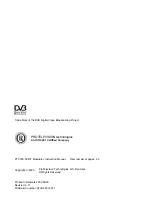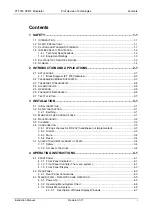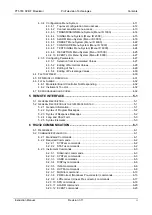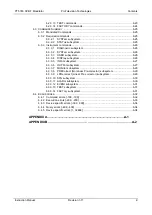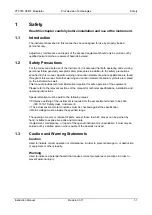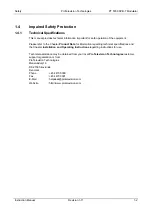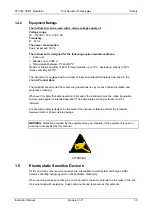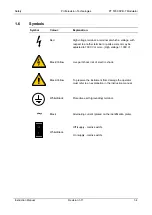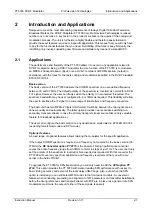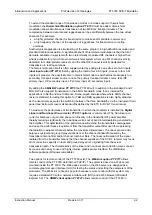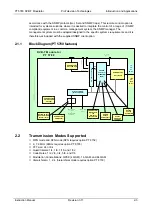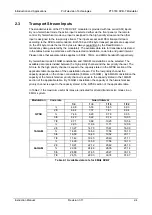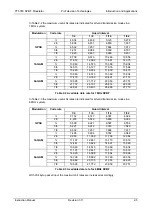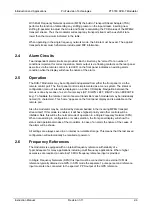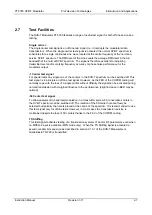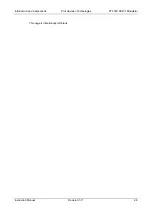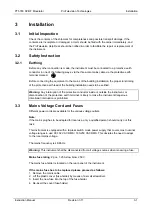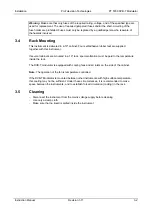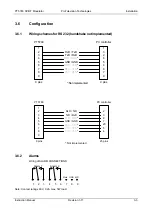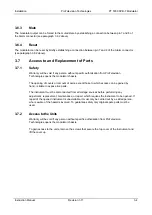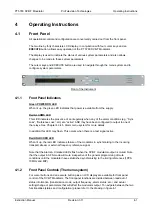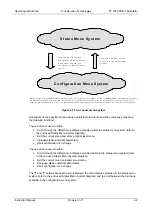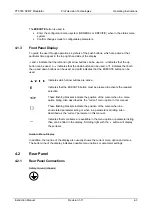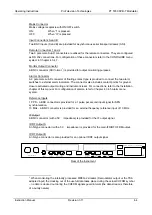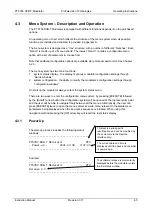
Introduction and Applications
ProTelevision Technologies
PT 5780 DVB-T Modulator
Instruction Manual
Revision 3.11
2-2
To extend the standard range of transmission modes to include support of hierarchical
modulation the
Hierarchical Modulation option PT 8733
must be added. Hierarchical
modulation allows simultaneous transmission of two MPEG-2 transport streams. The
compromise between data rate and ruggedness can be set differently between the two virtual
channels. For example:
•
a highly protected channel for transmission to mobile and/or portable receivers and
•
a high capacity channel, at the expense of ruggedness, for transmission to rooftop
antennas.
Another typical application is simulcasting of the same program in high definition resolution and
standard definition resolution. A significant benefit of hierarchical modulation is that the total
data-rate available in a system with two hierarchically modulated RF channels is higher than
what is available for a two-channel non-hierarchical system where one RF channel is strictly
dedicated to mobile/portable receivers and the other RF channel is strictly dedicated for
transmission to rooftop antennas.
The hierarchical option itself is often supplemented by adding also an extra set of ASI inputs
(
dual input option PT 8716
) thereby upping the total to four ASI inputs. Access to four ASI
inputs will preserve the possibility also in hierarchical mode to switch almost seamlessly to a
secondary transport stream source in case the primary transport stream source fails (HP
primary input, HP secondary input, LP primary input, LP secondary input).
By adding the
6MHz BW option PT 8735
the PT 5780 will, in addition to the standard 8 and 7
MHz BW, also support transmission in the 6MHz bandwidth mode that is intended for
applications in North and South America, Korea, Japan and elsewhere where 6MHz channel
raster is standard. Including this option for T&M and R&D applications is also highly attractive
as the user simply executes the switching between the three bandwidths via the instrument front
panel (one instrument covers all bandwidths defined by the ETS for DVB-T transmission).
To maximise the performance of the transmitter in which the modulator is installed the
Digital
Linear and Non-linear Pre-corrector PT 8731 option
is recommended. The
Non-linear pre-
corrector
balances out gain and phase non-linearity in the transmitter RF power amplifier
thereby reducing significantly the in-band as well as out of band intermodulation generated by
the amplifier. This optimisation of the performance will extend the transmitters coverage area
and ease the performance requirement from the transmitter output filter used for suppressing
the radiation in adjacent channels below the maximum allowed level. The
linear pre-corrector
balances out level and group delay variations over the channel bandwidth caused by the
transmitter antenna filter and/or channel combiner filers. The linear optimisation of the signal
radiated from the transmitter means that the channel equalizer of the DVB-T receiver may focus
all its correction capacity on level and group delay errors originating from the actual
transmission path. The characteristics of the linear and non-linear pre-correction curves are set
by means of an easy to use and highly intuitive graphical user interface, the IMD Buster
software package (Windows compatible).
Two options for remote control of the PT 5780 exist. The
WebLink option PT 8717
allows
remote control of the PT 5780 via Ethernet (TCP/IP). The system is based on a Web server
mounted inside the PT 5780. The Web pages stored on the Web server are designed as a
complete graphical user interface (GUI) for testing the status and setting the parameters of the
modulator. The
WebLink
concept is popular because remote control with this system only
requires a standard PC with a network interface card (NIC) and a Web browser (Microsoft
Explorer 5.0). The
SNMP client option PT 8727
allows remote control of the PT 5780 in
Содержание PT 5780
Страница 94: ......


